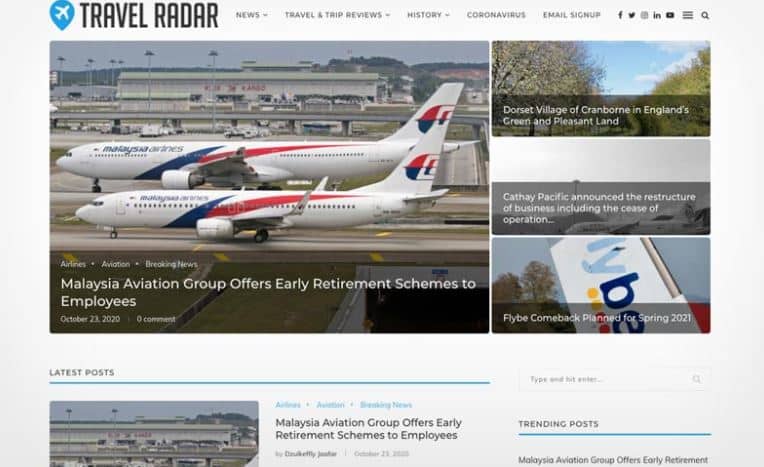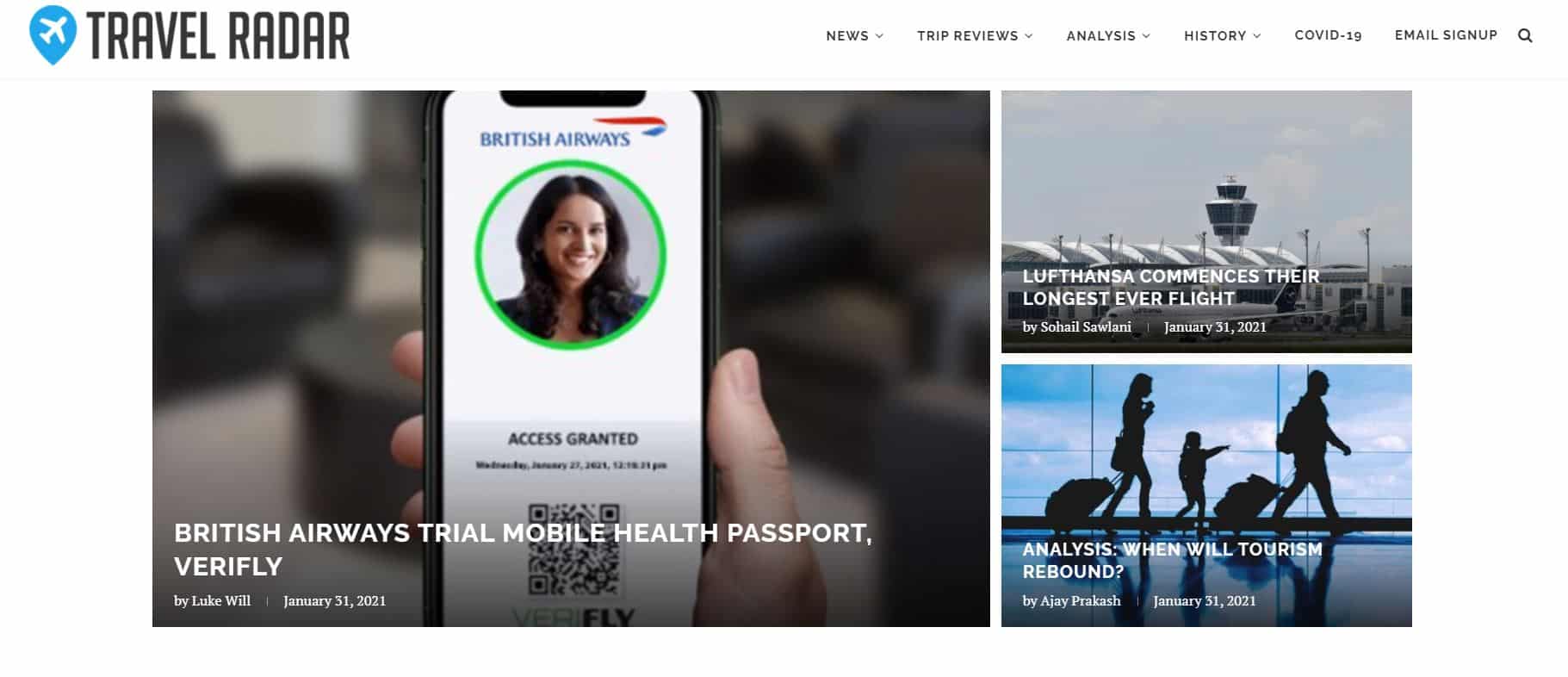Audience engagement expert Bibblio is shining a spotlight on the many multi-platform magazine publishers that are thriving via its “Vertical Heroes” series of interviews. Here, Bibblio Co-Founder Rich Simmonds speaks with Travel Radar about developing an engaged audience and thinking ‘mobile-first’.
Few industries have been impacted by COVID-19 so wholesale as aviation. S&P Global Ratings predicts a drop in global air passenger traffic by up to 70 per cent across all of 2020, with a return to pre-pandemic levels expected by 2024. Cost-cutting, fleet size and liquidity preservation are priorities for airlines currently.
All this intrigue, alongside positive news stories and historical insights, is being reported in Travel Radar, a large source of news and analysis for all things aviation. Based in the UK, this online publication has grown over five years from humble beginnings to serving around 10 million users a month.

Travel Radar’s Founder and Chief Executive Luke Willmoth found time to speak to Bibblio Co-Founder Rich Simmonds about data-driven success, revenue diversification and the importance of mobile-first to their audience.
Rich: Hi Luke. So let’s begin by telling me about Travel Radar’s target audience?
Luke: We typically cater to a tri-tiered audience base composed of AvGeeks, frequent fliers and the wider public. Our AvGeek audience is typically composed of industry enthusiasts who are passionate for aircraft, the wider world of aviation and are typically very detail-seeking.
Our next group are the frequent fliers, both commercial and business travellers, who travel a lot and are keen to find the best deals, airlines and inflight entertainment and experience news.
Finally, a lot of our content appeals to the everyday public, who are interested in the latest advancements in aviation be that regional connectivity through routes, the latest technological advancements or safety/incident reports.
R: What different types of content are you offering them?
L: We offer a diverse range of topics and content on Travel Radar. Our key priority is being a leading source for industry news (which drives the most traffic), but this is consolidated with more in-depth analysis from our industry-expert writers, and then more review-based content on travel, airports and airline experiences.
A growing trend recently too, has been the evolution of evergreen content on interesting ‘Did you Know’ topics across the industry; little nuggets and quirks of information that appeals to the wider audience base that’s catered to on Travel Radar.
R: How large is Travel Radar in terms of audience and team?
L: We have become quite sizeable in the past year, growing vastly beyond our original origin as a “community interest/aviation community” Facebook page back in 2015. Travel Radar currently reaches around 10 million users per month via our various channels, with around 150 million yearly impressions.
In terms of staffing, we have also grown quite rapidly in the past year or so, with about 50 staff members currently. A large majority of these are based in front-end content production, and the latter half more on the business and personal development side of things.
R: You’ve grown impressively – what has been the secret sauce?
L: I’d say there are two things that have most significantly contributed to our growth. The first is a high-quality reliable stream of content, pitched as reliable and in-depth, compared to other non specialist news verticals.
Secondly, one of the areas I’ve always been big on is backend process. Our amazing staff development, perks program and internal HR team has been critical to gaining, developing and retaining our incredible content and business development teams and work with freelancers, interns and volunteers that are industry specialists, but may not necessarily hold a ton of journalistic experience.
R: How do you prioritise attracting new audiences vs. engaging existing users deeper?
L: As a news vertical, acquisition of new readers and growth is on equal par with our regular engagement with existing readers. We try to balance the two to bring a constant stream of new readers in – via both social and SEO channels – but also build rapport and trust amongst our existing user base to re-engage them with the content we produce.
We are hoping with the upcoming launch of our mobile app, podcast and a few other projects on the horizon, we can work more on that retention rate and consistent engagement of our readers.

R: What are the key audience metrics you define success by?
L: We look at a range of detailed analytics and metrics of our audience to define our success and areas for growth, and have a dedicated group that work on this quarterly to inform and steer the publication in the right direction.
I believe data-driven business is the way of the future, and the level of detail and quality we can derive through the insights of our audience is absolutely vital in optimizing both current and future workflows of Travel Radar.
We look at stats such as new users to the site, return rate of visitors, but also the deeper analytics of bounce rate, and click-through patterns – analysing the areas users of our site are frequent visitors of, and understanding why this content is favored over other pieces.
R: Define what SEO means to you these days. Keywords, page speed, engagement?
L: SEO-rigor is something we build into our editorial process, and a step we see as vital to the continued growth in reach of our content.
We’ve recently finished a period of A/B testing of traffic channels, cutting and growing our efforts between social and organic, and have began analysing the strengths and weaknesses of both of these channels on user-click conversions.
On the editorial side, good quality content is a key factor to our SEO success, and with this comes on-page optimisation of all elements: copy and media assets within articles.
On the development side, our tech folk are constantly working to increase page speed, indexing and user experience across mobile, tablet and desktop channels, to optimise the site and its content across all three device types.
We see user activity as a key metric on things like click-through, bounce rate and engagement.
R: What’s your social media strategy, and how important is it for you to be present on those platforms?
L: Social media has always been our origin as a publication, and something we’ve stuck true to throughout recent years. We have a dedicated social media team with channel specialists for Facebook, Twitter, Instagram and LinkedIn, as well as our projects team looking to innovate on upcoming platforms like TikTok to reach a new audience base.
We see a presence on these platforms as vital to growth, and such a presence forms a large part of our audience base.
R: Could you shed a bit of light on your revenue model?
L: At present, monetisation is a large part of our revenue model, with the majority of revenue coming through third-party advertisements within our content. These are from a mix of sources including dedicated contracts with industry companies seeking exposure amongst our audience, and ad vendors which serve a mixed form of advertisement on our site.
In the near future, we are looking at launching a subscription-based model for our readers, unlike anything seen in the industry at the moment which we’re super-excited for!
R: How do you drive visitors to your affiliate and sponsored content?
L: Affiliates are less of what we do day-to-day, but we do have some unique offerings to our readers such as our SELECT Membership discount, and credit card affiliates. These are more passive streams though, and we tend to embed these at the end of relevant articles as an optional consideration for our readers, rather than push these across various aspects of our content and site.
Sponsored content makes up a small minority of content and is usually for airlines, airports or industry attractions which our audience may be interested in. We typically see a high engagement rate with sponsored content as we ensure quality and relevance is highly related to our audience’s interests.
R: What’s your fastest growing area?
L: We’ve always seen a huge leaning towards mobile use by our audience – around 75 per cent. Due to this, we made the decision a year ago to begin working on a new ‘Travel Radar App’ set to launch soon. We’re really excited to see how this builds engagement amongst these mobile users, and the versatility this will give us to develop innovative new features, technologies and engagement channels in the coming year.
R: From your own journey, what do you think other vertical publishers could learn?
L: I think the joint efforts of front-end quality content, and back-end company structure have been the most successful parts of our model.
To other vertical publishers, or those wanting to establish in vertical publishing, I’d emphasise the importance of building an internal culture of passion for the niche you’re operating within, and working with people with a true passion for the content being produced.
With the passion of our staff, I’m pleased that our content can offer critique, comment and analysis beyond that of other publications and though remotely-based, our team culture makes for a very enjoyable workplace!
R: Can you share some milestones with us?
L: With an audience of around 52 per cent in the US, UK or Europe, large carrier news and deliveries often do extremely well for us. For example, we experienced a 80 per cent spike in traffic last year when we exclusively reported live from British Airways’ A350 delivery, and the unveiling of their new ‘Club Suite’ business class product.
We are also seeing a growing trend of users in the Middle East and UAE, with a lot of traffic (around 45 per cent of our total in August) to articles of a recent delivery and Wizzair UAE expansion.
There is also a continued trend of interest in analysis and critical comment pieces from our editorial team, offering a bit of a ‘deeper look’ into stories than typical news reporting.
R: Which other publishers do you look to for inspiration?
L: I’ve always had a passion for communication and media, and took a lot of my inspiration of Travel Radar through traditional quality publications like The FT and Business Insider, but also innovative new start-ups like Skift and LADbible who have high engagement and reader-loyalty rates amongst a diverse audience-base.
It’s our aim at Travel Radar to become that quality but innovative source of air travel and aviation news.







